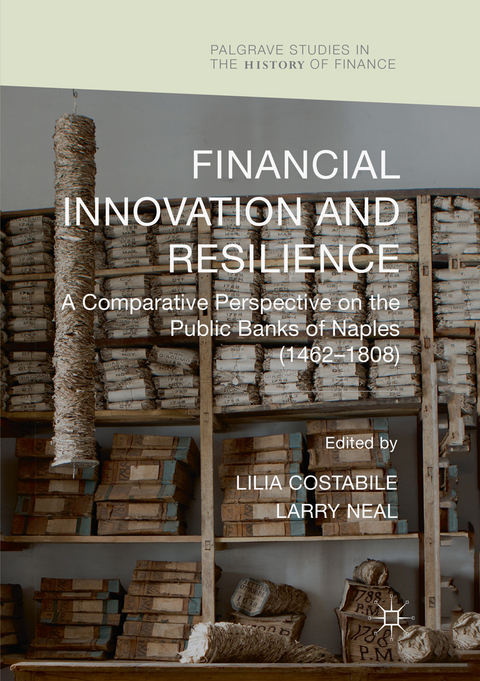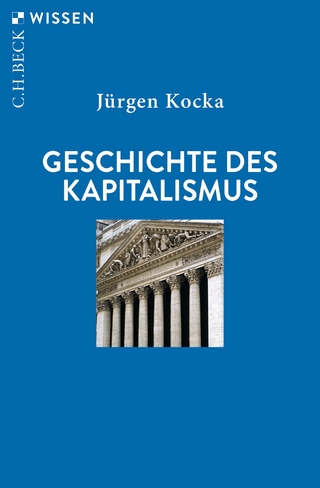
Financial Innovation and Resilience
Springer International Publishing (Verlag)
978-3-030-07973-4 (ISBN)
As Ignazio Visco, Governor of the Bank of Italy, says in his Foreword, all economic policy makers today need to re-examine our history to help them confront the challenges of today. This edited volume focuses specifically on the theme of financial innovation and how financial resiliency was achieved in Naples. To highlight both the achievements of the public banks of Naples and their lessons for financial resiliency, the book focuses on financial crises and how they were overcome in Naples in contrast to other European financial systems.
The first section focuses on the development of the public banks unique to Naples. The second section compares those with other banking systems and how they responded to the same shock in 1622, caused by the full mobilization of European belligerents to finance their efforts in the Thirty Years War. The next section compares lessons learned in the rest of Europe over the next century and a half. The final section comes back to original start of the narrative arc to suggest ways that today's policymakers and thinkers could use the historical experience of the public banks of Naples to deal better with the ongoing problems stemming from the financial crisis of 2007-08.
Lilia Costabile is Full Professor of Economics at the University of Naples Federico II. She received her PhD at the University of Cambridge, where she is also Life Member of Clare Hall. In 2016 she received the Prize of the President of the Italian Republic, awarded by the Accademia dei Lincei, for her research in Economics. She is currently involved in a project on "Minimalism and Activism in Central Banking: Lesson from the History of Economic Thought" funded by the ECB through ESHET. She has published widely in academic journals and is the author of a book on Malthus: Sviluppo e ristagno della produzione capitalistica as well as the editor of Istituzioni e sviluppo economico nel Mezzogiorno, and Institutions for Social Well-Being: Alternatives for Europe. Larry Neal is Emeritus Professor of Economics at the University of Illinois at Urbana-Champaign, and Research Associate of the National Bureau of Economic Research. Co-editor of the 2-volume Cambridge History of Capitalism, and the 4-volume History of Financial Crises, his books include The Rise of Financial Capitalism: International Capital Markets in the Age of Reason, 'I am not master of events': The Speculations of John Law and Lord Londonderry in the Mississippi and South Sea Bubbles, and A Concise History of International Finance: From Babylon to Bernanke.
Chapter 1. The Pattern of Central Bank Development: Past, Present and Future; C. A. E. Goodhart.- Part I. The Rise of Modern Banking in Naples. Chapter 2. The Public Banks of Naples between Financial Innovation and Crisis; Lilia Costabile and Eduardo Nappi.- Chapter 3. Before the Public Banks: Innovation and Resilience by Charities in Fifteenth Century Naples; Rosalba Di Meglio.- Chapter 4. Between Assistance and Credit: The Evolution of the Neapolitan Banking System (16th - 17th Century); Paola Avallone and Raffaella Salvemini.- Chapter 5. The Investments of Neapolitan Public Banks: a Long Run View (1587-1863); Francesco Balletta, Luigi Balletta and Eduardo Nappi.- Part II. Comparative Perspectives on the Rise of Public Banks.- Chapter 6. The Variety of Financial Innovations in European War Finance during the Thirty Years' War; Larry Neal.-Chapter 7. A Tale of Three Banking Systems: Florence, Genoa and Venice in the Renaissance; Luciano Pezzolo.- Chapter 8. Conflicts, Financial Innovations, and Economic Trends in the Italian States during the Thirty Years' War; Giuseppe De Luca and Marcella Lorenzini.- Chapter 9. Experimenting with Paper Money during the English Civil Wars and Interregnum: Monetisation versus Securitisation, 1643-1663; D'Maris Coffman.- Part III. Comparative Perspectives on the Spread of Public Banks.- Chapter 10. Neapolitan Banks in the Context of Early Modern Europe; François Velde.- Chapter 11 The Institutional Foundations of Successful Public Borrowing - Models of Public Banks in Habsburg Austria and Habsburg Naples 1700-1800; Clemens Jobst.- Chapter 12. John Law: a Twenty-first Century Banker in the Eighteenth Century; Antoin E. Murphy.- Chapter 13. The Bank of Amsterdam's Search for Success and Stability; Stephen Quinn and William Roberds.- Part IV. Lessons from the Past for the Future?.- Chapter 14. Banks, Financial Markets, and the Development of International Currencies; Barry Eichengreen.- Chapter 15. Public Banks, Public Orientation and the Great Financial Crisis of 2007-2008; Gerald Epstein and Devika Dutt.- Chapter 16. Profit and Non-Profit Motives in the Public Banks of Naples: An Old Model in Modern Perspective; Adriano Giannola.
| Erscheinungsdatum | 19.02.2019 |
|---|---|
| Reihe/Serie | Palgrave Studies in the History of Finance |
| Zusatzinfo | XXXVI, 372 p. 35 illus., 15 illus. in color. |
| Verlagsort | Cham |
| Sprache | englisch |
| Maße | 148 x 210 mm |
| Gewicht | 531 g |
| Themenwelt | Geschichte ► Teilgebiete der Geschichte ► Wirtschaftsgeschichte |
| Wirtschaft ► Allgemeines / Lexika | |
| Wirtschaft ► Betriebswirtschaft / Management ► Finanzierung | |
| Betriebswirtschaft / Management ► Spezielle Betriebswirtschaftslehre ► Bankbetriebslehre | |
| Schlagworte | bank finance • Banking • Financial Crises • Financial innovation • financial resiliency • Financial Systems • Public Banks • public banks of Naples |
| ISBN-10 | 3-030-07973-2 / 3030079732 |
| ISBN-13 | 978-3-030-07973-4 / 9783030079734 |
| Zustand | Neuware |
| Haben Sie eine Frage zum Produkt? |
aus dem Bereich


